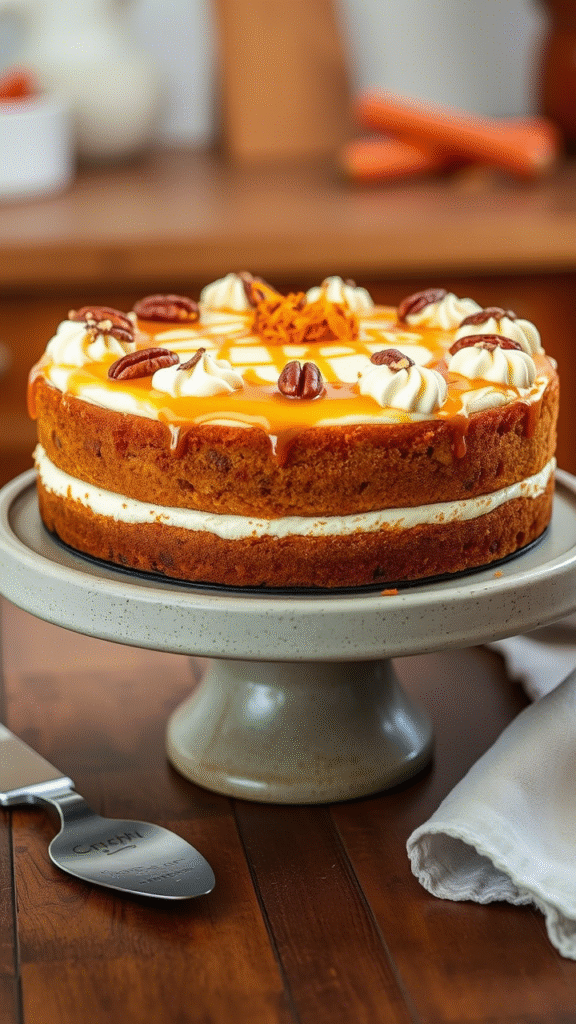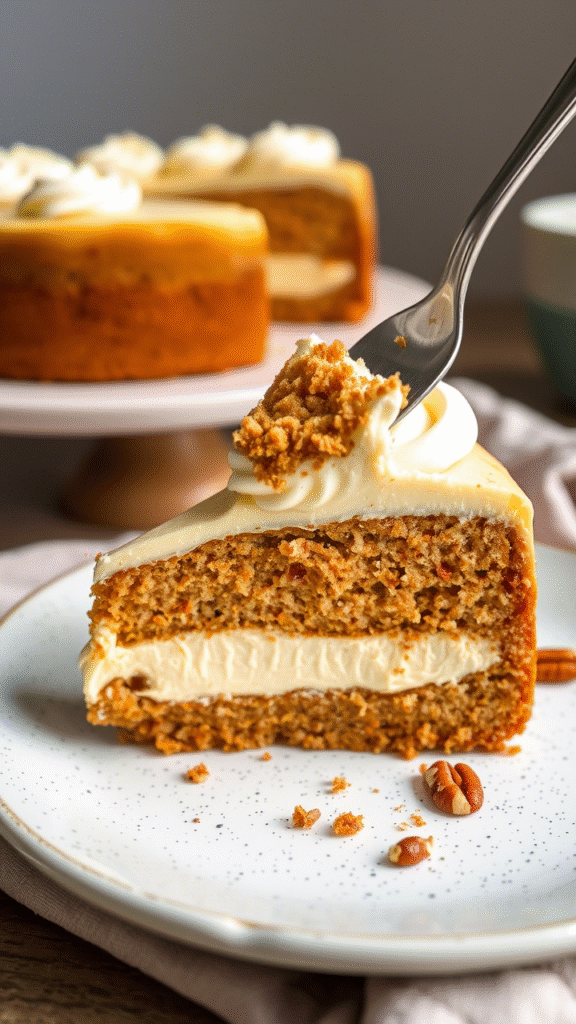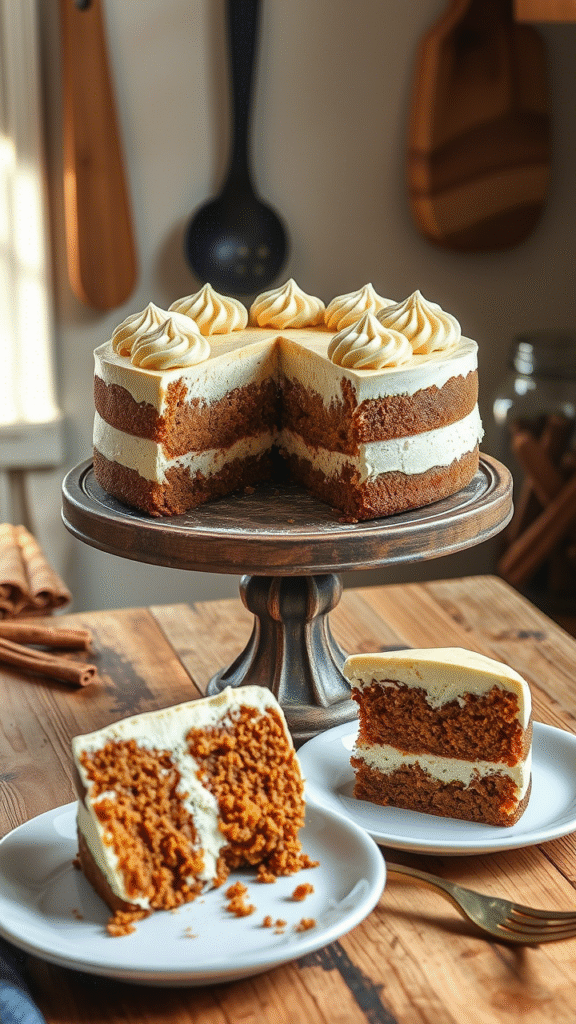Ever had a dessert so good it made you pause mid-bite? Like you’re halfway through a sentence and suddenly silence, because your mouth’s too busy decoding joy? Yeah. That was me the first time I tasted carrot cake cheesecake. It wasn’t at a five-star joint. It was at a noisy backyard barbecue, of all places. But the second that fork hit the plate, I knew—this wasn’t just another dessert. This was a flavor paradox that worked. Creamy and tangy, earthy and spiced. Silky meets crumbly. A whole love story in one slice.
Carrot cake cheesecake is exactly what it sounds like: a hybrid of two classic desserts that, frankly, have no business getting along as well as they do. You take the warm, spiced character of a good old-fashioned carrot cake and smash it right into the cool, lush elegance of cheesecake. It’s chaos. Controlled, delicious chaos.
Let’s break it down, build it up, and figure out how to make this thing sing.
Ingredients & Substitutions
This ain’t your average dump-and-stir cake. Every element matters. Start with the best stuff you can get your hands on.
For the Carrot Cake Layer:
- 1 cup all-purpose flour (or sub 50/50 with whole wheat for nuttier depth)
- 1 tsp baking powder
- ½ tsp baking soda
- ½ tsp salt
- 1 tsp ground cinnamon
- ½ tsp ground nutmeg
- ¼ tsp ground cloves
- ½ cup granulated sugar
- ½ cup light brown sugar (don’t skip—molasses content gives moisture)
- 2 large eggs
- ⅓ cup vegetable oil (neutral, but coconut oil works for tropical twist)
- 1 tsp vanilla extract
- 1 ½ cups finely grated carrots (fresh! Don’t use pre-shredded. Ever.)
- ½ cup crushed pineapple, drained (adds moistness and tang)
- ½ cup chopped walnuts or pecans (or leave out if nut-free)
- Optional: ⅓ cup shredded coconut
For the Cheesecake Layer:
- 2 x 8 oz blocks of full-fat cream cheese, softened (no low-fat nonsense)
- ½ cup granulated sugar
- 2 large eggs
- 2 tsp vanilla extract
- 2 tbsp sour cream (key for tang and smooth texture)
- 1 tbsp all-purpose flour (helps set the batter slightly firmer)
For the Cream Cheese Frosting (optional but… not really):
- 4 oz cream cheese, softened
- 2 tbsp unsalted butter, softened
- 1 cup powdered sugar, sifted
- ½ tsp vanilla extract
- Pinch of salt
Substitutions & Tips:
- Dairy-free? Use vegan cream cheese and coconut cream in place of sour cream. Works shockingly well.
- Egg-free? Swap in a flax egg (1 tbsp ground flax + 3 tbsp water per egg). Texture’s slightly softer but still holds.
- No pineapple? Unsweetened applesauce makes a decent stand-in.
Step-by-Step Instructions

There’s layering involved. Timing. And a bit of trust. But don’t worry—we’ll walk it like a tightrope.
1. Prep the Pan
Line the bottom of a 9-inch springform pan with parchment and lightly grease the sides. Don’t skip the parchment. Saves tears later.
2. Mix the Cheesecake Batter
In a stand mixer or with a hand mixer, beat cream cheese until smooth and fluffy. No lumps allowed. Scrape the bowl—twice.
Add sugar and beat again. Then eggs, one at a time. Vanilla, sour cream, and flour go in last. Beat till creamy, not soupy. Set aside.
Pro Tip: Overbeating adds air. Too much air = cracks. Be smooth, not overzealous.
3. Make the Carrot Cake Batter
Whisk all the dry ingredients together in one bowl. That includes spices, which you don’t want clumping in the middle of a bite.
In another bowl, whisk eggs, sugars, oil, and vanilla. Fold in the carrots, pineapple, and nuts. Don’t overmix—just until it comes together.
4. Layer Like a Pro
Pour just over half of the carrot cake batter into the bottom of your springform pan. Gently spoon all the cheesecake batter over that.
Here’s where most people mess up: don’t just plop the rest of the carrot cake batter on top. Dollop it. Gently. Then use a knife or skewer to swirl a little, if you want that marbled effect.
5. Bake Low & Slow
Bake at 325°F (160°C) for about 65–75 minutes. It’s done when the center jiggles slightly but the edges are set.
Water Bath? You can, but I usually don’t. Instead, place a pan of hot water on the rack below. Keeps humidity up without the hassle.
Let cool in the oven with the door slightly open for 30 minutes. Then refrigerate at least 6 hours or overnight. This ain’t a same-day dessert, sorry.
6. Make the Frosting
Beat cream cheese and butter until smooth. Add powdered sugar gradually. Vanilla and salt last. Don’t skip the salt—it wakes everything up.
Spread or pipe over the chilled cake. Garnish with chopped walnuts, candied carrot ribbons, or just leave it naked and let the swirls talk.
Cooking Techniques & Science

Let’s geek out for a sec.
Why pineapple? Besides flavor, pineapple has bromelain, an enzyme that tenderizes. It breaks down protein fibers in the carrot, softening the crumb without making it soggy.
Why two layers, not mixed? It’s a texture game. Cheesecake and carrot cake bake at different rates and have different densities. Layering keeps structure while blending flavor.
The flour in the cheesecake? It stabilizes the batter. Without it, the cheesecake layer might crack or sink. Just a little helps it firm up while staying silky.
Mixing order matters. In the carrot cake batter, adding carrots last prevents excess liquid from releasing too early. Keeps batter from turning wet.
Tool Talk: A springform pan is non-negotiable. And a long offset spatula helps with frosting smoothness like nobody’s business.
Serving & Pairing Suggestions

Here’s the part where you turn a slice into an experience.
Presentation Ideas:
- Dust with cinnamon and powdered sugar for a rustic look.
- Pipe tiny cream cheese rosettes along the edge.
- Garnish with candied ginger for a spicy pop.
Serve With:
- A dry Riesling or chilled Moscato—something with acid to cut the richness.
- Hot chai or spiced black tea.
- For brunch? Pair it with thick-cut bacon and black coffee. Trust me.
This cake’s not shy. It likes company with contrast—bitter, salty, acidic.
Final Thoughts
Carrot cake cheesecake is an unapologetic showstopper. It’s a little chaotic, sure. But every layer has its role. The earthy sweetness of carrots. The plush tang of cream cheese. Spices that hum in the background like backup singers in a soul band.
Is it fussy? A bit. But what masterpiece isn’t?
Here’s my last advice: don’t rush the chill time. Give it space to set and bloom. This isn’t just baking. It’s aging to perfection.
FAQs
1. Can I freeze carrot cake cheesecake?
Yep. Wrap it tight in plastic and foil. Freeze for up to 2 months. Thaw in the fridge overnight, not on the counter. That’ll keep the texture intact.
2. Why did my cheesecake crack?
Could be overbeating, baking too fast, or cooling too quickly. Always cool slowly and avoid opening the oven mid-bake.
3. Can I make this gluten-free?
Totally. Sub a 1:1 gluten-free flour blend. Choose one with xanthan gum for better structure.
4. Is this recipe good for cupcakes?
With adjustments, yes. Use muffin tins and bake at 325°F for ~25 minutes. Skip the swirling—just layer.
5. Do I have to use a water bath?
Not strictly, but it helps prevent cracks. The pan-of-hot-water-on-lower-rack method is my lazy baker’s workaround.
Ever had a dessert so good it made you pause mid-bite? Like you’re halfway through a sentence and suddenly silence, because your mouth’s too busy decoding joy? Yeah. That was me the first time I tasted carrot cake cheesecake. It wasn’t at a five-star joint. It was at a noisy backyard barbecue, of all places. But the second that fork hit the plate, I knew—this wasn’t just another dessert. This was a flavor paradox that worked. Creamy and tangy, earthy and spiced. Silky meets crumbly. A whole love story in one slice.
Carrot cake cheesecake is exactly what it sounds like: a hybrid of two classic desserts that, frankly, have no business getting along as well as they do. You take the warm, spiced character of a good old-fashioned carrot cake and smash it right into the cool, lush elegance of cheesecake. It’s chaos. Controlled, delicious chaos.
Let’s break it down, build it up, and figure out how to make this thing sing.
Ingredients & Substitutions
This ain’t your average dump-and-stir cake. Every element matters. Start with the best stuff you can get your hands on.
For the Carrot Cake Layer:
- 1 cup all-purpose flour (or sub 50/50 with whole wheat for nuttier depth)
- 1 tsp baking powder
- ½ tsp baking soda
- ½ tsp salt
- 1 tsp ground cinnamon
- ½ tsp ground nutmeg
- ¼ tsp ground cloves
- ½ cup granulated sugar
- ½ cup light brown sugar (don’t skip—molasses content gives moisture)
- 2 large eggs
- ⅓ cup vegetable oil (neutral, but coconut oil works for tropical twist)
- 1 tsp vanilla extract
- 1 ½ cups finely grated carrots (fresh! Don’t use pre-shredded. Ever.)
- ½ cup crushed pineapple, drained (adds moistness and tang)
- ½ cup chopped walnuts or pecans (or leave out if nut-free)
- Optional: ⅓ cup shredded coconut
For the Cheesecake Layer:
- 2 x 8 oz blocks of full-fat cream cheese, softened (no low-fat nonsense)
- ½ cup granulated sugar
- 2 large eggs
- 2 tsp vanilla extract
- 2 tbsp sour cream (key for tang and smooth texture)
- 1 tbsp all-purpose flour (helps set the batter slightly firmer)
For the Cream Cheese Frosting (optional but… not really):
- 4 oz cream cheese, softened
- 2 tbsp unsalted butter, softened
- 1 cup powdered sugar, sifted
- ½ tsp vanilla extract
- Pinch of salt
Substitutions & Tips:
- Dairy-free? Use vegan cream cheese and coconut cream in place of sour cream. Works shockingly well.
- Egg-free? Swap in a flax egg (1 tbsp ground flax + 3 tbsp water per egg). Texture’s slightly softer but still holds.
- No pineapple? Unsweetened applesauce makes a decent stand-in.
Step-by-Step Instructions
There’s layering involved. Timing. And a bit of trust. But don’t worry—we’ll walk it like a tightrope.
1. Prep the Pan
Line the bottom of a 9-inch springform pan with parchment and lightly grease the sides. Don’t skip the parchment. Saves tears later.
2. Mix the Cheesecake Batter
In a stand mixer or with a hand mixer, beat cream cheese until smooth and fluffy. No lumps allowed. Scrape the bowl—twice.
Add sugar and beat again. Then eggs, one at a time. Vanilla, sour cream, and flour go in last. Beat till creamy, not soupy. Set aside.
Pro Tip: Overbeating adds air. Too much air = cracks. Be smooth, not overzealous.
3. Make the Carrot Cake Batter
Whisk all the dry ingredients together in one bowl. That includes spices, which you don’t want clumping in the middle of a bite.
In another bowl, whisk eggs, sugars, oil, and vanilla. Fold in the carrots, pineapple, and nuts. Don’t overmix—just until it comes together.
4. Layer Like a Pro
Pour just over half of the carrot cake batter into the bottom of your springform pan. Gently spoon all the cheesecake batter over that.
Here’s where most people mess up: don’t just plop the rest of the carrot cake batter on top. Dollop it. Gently. Then use a knife or skewer to swirl a little, if you want that marbled effect.
5. Bake Low & Slow
Bake at 325°F (160°C) for about 65–75 minutes. It’s done when the center jiggles slightly but the edges are set.
Water Bath? You can, but I usually don’t. Instead, place a pan of hot water on the rack below. Keeps humidity up without the hassle.
Let cool in the oven with the door slightly open for 30 minutes. Then refrigerate at least 6 hours or overnight. This ain’t a same-day dessert, sorry.
6. Make the Frosting
Beat cream cheese and butter until smooth. Add powdered sugar gradually. Vanilla and salt last. Don’t skip the salt—it wakes everything up.
Spread or pipe over the chilled cake. Garnish with chopped walnuts, candied carrot ribbons, or just leave it naked and let the swirls talk.
Cooking Techniques & Science
Let’s geek out for a sec.
Why pineapple? Besides flavor, pineapple has bromelain, an enzyme that tenderizes. It breaks down protein fibers in the carrot, softening the crumb without making it soggy.
Why two layers, not mixed? It’s a texture game. Cheesecake and carrot cake bake at different rates and have different densities. Layering keeps structure while blending flavor.
The flour in the cheesecake? It stabilizes the batter. Without it, the cheesecake layer might crack or sink. Just a little helps it firm up while staying silky.
Mixing order matters. In the carrot cake batter, adding carrots last prevents excess liquid from releasing too early. Keeps batter from turning wet.
Tool Talk: A springform pan is non-negotiable. And a long offset spatula helps with frosting smoothness like nobody’s business.
Serving & Pairing Suggestions
Here’s the part where you turn a slice into an experience.
Presentation Ideas:
- Dust with cinnamon and powdered sugar for a rustic look.
- Pipe tiny cream cheese rosettes along the edge.
- Garnish with candied ginger for a spicy pop.
Serve With:
- A dry Riesling or chilled Moscato—something with acid to cut the richness.
- Hot chai or spiced black tea.
- For brunch? Pair it with thick-cut bacon and black coffee. Trust me.
This cake’s not shy. It likes company with contrast—bitter, salty, acidic.
Final Thoughts
Carrot cake cheesecake is an unapologetic showstopper. It’s a little chaotic, sure. But every layer has its role. The earthy sweetness of carrots. The plush tang of cream cheese. Spices that hum in the background like backup singers in a soul band.
Is it fussy? A bit. But what masterpiece isn’t?
Here’s my last advice: don’t rush the chill time. Give it space to set and bloom. This isn’t just baking. It’s aging to perfection.
FAQs
1. Can I freeze carrot cake cheesecake?
Yep. Wrap it tight in plastic and foil. Freeze for up to 2 months. Thaw in the fridge overnight, not on the counter. That’ll keep the texture intact.
2. Why did my cheesecake crack?
Could be overbeating, baking too fast, or cooling too quickly. Always cool slowly and avoid opening the oven mid-bake.
3. Can I make this gluten-free?
Totally. Sub a 1:1 gluten-free flour blend. Choose one with xanthan gum for better structure.
4. Is this recipe good for cupcakes?
With adjustments, yes. Use muffin tins and bake at 325°F for ~25 minutes. Skip the swirling—just layer.
5. Do I have to use a water bath?
Not strictly, but it helps prevent cracks. The pan-of-hot-water-on-lower-rack method is my lazy baker’s workaround.

Food lover, recipe creator & the heart behind NoshCrafters.com. Olivia shares mouthwatering, easy-to-make dishes that turn everyday meals into unforgettable bites. When she’s not experimenting in the kitchen, she’s busy plating up inspiration for home cooks everywhere.